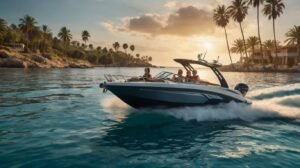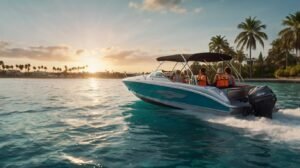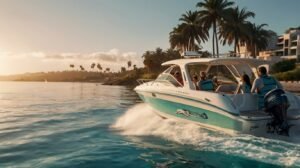
Introduction
Boat insurance is not just a legal formality; it’s a vital shield for boat owners against financial loss and liabilities associated with boating activities. As the boating industry continues to grow, with millions of Americans taking to the water each year, understanding the ins and outs of boat insurance becomes increasingly important. The landscape of boat insurance is evolving, especially in 2025, influenced by technological advancements, changing regulations, and an uptick in recreational boating activities.
In this comprehensive guide, we’ll delve into the various types of boat insurance coverage available, the claims process, and the factors that influence costs. Whether you own a small kayak or a luxurious yacht, understanding your insurance options is essential for protecting your investment and ensuring peace of mind on the water.
We will explore the nuances of liability coverage, physical damage coverage, and additional options that can tailor a policy to meet your specific needs. Furthermore, we’ll address common misconceptions about boat insurance that may lead to inadequate coverage or unexpected costs.
For new and seasoned boaters alike, the importance of having the right insurance cannot be overstated. An accident on the water can lead to significant financial repercussions, and without adequate insurance, these costs can quickly spiral out of control.
As we navigate through the complexities of boat insurance, it’s also vital to stay informed about the latest trends and changes in the industry. For more detailed information and resources, don’t hesitate to visit us at “zaroraterishta.com.” By the end of this article, you’ll be equipped with the knowledge needed to make informed decisions regarding your boat insurance policy in 2025.
1. Understanding Boat Insurance
Boat insurance is a specialized form of insurance that provides financial protection for boat owners against various risks. It is designed to cover a wide range of incidents, from accidents on the water to theft and damage caused by natural disasters. Understanding the different components of boat insurance is essential for any boat owner.
What Does Boat Insurance Cover?
Boat insurance typically covers several key areas:
– Liability: This aspect of coverage protects you if you’re found responsible for an accident that causes injury to another person or damage to someone else’s property.
– Physical Damage: This covers damage to your boat itself, whether from collisions, vandalism, or natural disasters.
– Medical Payments: This coverage pays for medical expenses incurred by you and your passengers in the event of an accident.
– Uninsured/Underinsured Boater Coverage: This protects you if you’re involved in an accident with a boater who does not have adequate insurance coverage.
Boating can be a fun pastime, but it also comes with its risks. Having a solid understanding of what boat insurance covers can help you choose the right policy that meets your needs.
Why Is Boat Insurance Important?
In many states, boat insurance is not just advisable; it’s required by law, especially for larger vessels. Even if it’s not mandatory in your state, having insurance is crucial for protecting your investment. Without it, you may be liable for significant financial losses, medical expenses, and legal fees resulting from accidents.
The importance of boat insurance extends beyond legal obligations. It serves as a safety net that allows you to enjoy your time on the water without the constant worry of financial repercussions. Imagine the peace of mind that comes from knowing you’re protected against accidents and unforeseen events.
2. Types of Boat Insurance Coverage
When it comes to boat insurance, understanding the different types of coverage available is essential. Each type of coverage serves a specific purpose, allowing boat owners to tailor their policies based on their unique needs.
Liability Coverage
Liability coverage is one of the most critical components of any boat insurance policy. It protects you if you’re found responsible for causing injury to another person or damaging someone else’s property while operating your boat.
For example, if you accidentally collide with another vessel, liability coverage can help cover the costs of medical expenses for injured parties and repairs to damaged property. Given the potential costs associated with accidents on the water, having sufficient liability coverage is essential.
Physical Damage Coverage
Physical damage coverage protects your boat against damage resulting from accidents, theft, or other incidents. This type of coverage is divided into two main components:
– Hull Coverage: This protects the boat’s structure from physical damage. Whether you’re involved in a collision or your boat sustains damage during a storm, hull coverage ensures that you won’t be left with hefty repair bills.
– Equipment Coverage: This aspect covers personal property on your boat, including fishing gear, safety equipment, and electronics. If your equipment is stolen or damaged, this coverage can help you recover the costs.
Comprehensive Coverage
Comprehensive coverage is designed to protect against non-collision incidents. This includes theft, fire, vandalism, and damage caused by natural disasters. For example, if your boat is stolen from your dock or damaged due to a hurricane, comprehensive coverage will help you recover your losses.
Uninsured/Underinsured Boater Coverage
This coverage is particularly important in situations where you’re involved in an accident with a boater who has little or no insurance. If the other party is at fault and doesn’t have adequate coverage to pay for your damages, uninsured/underinsured boater coverage ensures that you won’t be left to bear the financial burden alone.
Medical Payments Coverage
Medical payments coverage helps pay for medical expenses for you and your passengers in the event of an accident, regardless of who is at fault. This is particularly valuable for ensuring that everyone on board receives the necessary care without incurring out-of-pocket expenses.
Additional Coverage Options
As you explore boat insurance, you may also come across additional coverage options that can enhance your policy. These may include:
– Towing and Assistance Coverage: This coverage can help with towing your boat if it becomes inoperable, ensuring you’re not stranded on the water.
– Personal Effects Coverage: This coverage protects personal items on board, such as clothing, cameras, and electronics, from theft or damage.
– Agreed Value Coverage: This ensures that in the event of a total loss, you receive a pre-determined amount for your boat rather than its depreciated value.
Understanding the various types of coverage available allows you to customize your policy to fit your specific needs, ensuring that you’re adequately protected on the water.
3. Factors Influencing Boat Insurance Costs in 2025
The cost of boat insurance can vary widely based on several factors. Understanding what influences these costs can help you make informed decisions and potentially save on premiums.
Type and Size of the Boat
One of the most significant factors influencing insurance costs is the type and size of your boat. Larger and more expensive boats typically require higher premiums due to the increased risk and repair costs. For instance, a luxury yacht will usually cost more to insure than a small fishing boat.
Additionally, certain types of boats may be considered riskier to insure, leading to higher premiums. For example, speedboats and personal watercraft are often seen as higher risk due to their potential for accidents.
Boat Usage
How you plan to use your boat also affects insurance costs. Boats used for commercial purposes generally attract higher premiums than those used solely for recreational purposes. Frequent use of activities like watersports or fishing may also lead to increased rates.
Boats that are stored in high-risk areas or those that are used in hazardous conditions may also incur higher premiums due to the increased likelihood of claims.
Geographic Location
Your geographic location plays a crucial role in determining your boat insurance costs. Factors such as crime rates, weather patterns, and local regulations can influence premiums. For example, boats stored in areas prone to hurricanes or heavy storms may face higher rates.
Additionally, regions with higher incidences of boating accidents may also lead to increased premiums. Insurers assess risk based on the likelihood of claims in specific areas, which can significantly impact your insurance costs.
Safety Features
Boats equipped with safety features such as GPS tracking systems, fire extinguishers, and life jackets may qualify for discounts on insurance premiums. Insurers often reward boaters who take proactive measures to enhance safety and reduce risks.
If you’re considering upgrades or additional safety equipment for your boat, inquire with your insurer about potential discounts that may apply.
Insurance History
Your previous claims history can also affect your insurance rates. A clean record with no prior claims often results in lower premiums, while a history of frequent claims may lead to higher costs. Insurers view your claims history as an indicator of risk, and a poor record can lead to increased rates.
Credit Score
In some cases, insurers may consider your credit score when determining premiums. A higher credit score may lead to lower insurance rates, as insurers associate good credit with responsible behavior and lower risk.
Understanding these factors allows you to make informed decisions when shopping for boat insurance and may help you identify ways to lower your premiums.
4. How to Choose the Right Boat Insurance Policy
Selecting the right boat insurance policy can feel overwhelming, especially with so many options available. Here are some key steps to help you choose the best policy for your needs:
Assess Your Needs
Start by evaluating how you use your boat. Consider factors such as the type of boat you own, how often you use it, and where you typically operate it. Understanding your specific needs will help you determine what type of coverage is essential.
Compare Policies
Don’t settle for the first quote you receive. Take the time to compare multiple insurance providers and policies. Look for coverage options, limits, and exclusions that align with your needs. Websites that allow you to compare quotes from different insurers can be particularly useful in finding the best deal.
Evaluate Additional Options
Consider whether you need additional coverage options beyond the basics. If you frequently use your boat for watersports or fishing, you may want to invest in additional coverage for personal effects or towing assistance. Tailoring your policy to fit your lifestyle can provide added peace of mind.
Seek Professional Advice
If you’re unsure about which policy to choose, consider consulting with an insurance agent who specializes in marine insurance. They can provide valuable insights and help clarify your options, ensuring you make an informed decision.
Read the Fine Print
Before signing any policy, carefully read the terms and conditions. Pay attention to coverage limits, exclusions, and any specific requirements you must meet to keep your coverage valid. Understanding the fine print can prevent unpleasant surprises in the event of a claim.
By taking these steps, you can confidently choose the right boat insurance policy that protects you, your boat, and your financial interests.
5. The Boat Insurance Claims Process
Filing a claim can be a stressful experience, but knowing the process can help ease the burden. Here’s a step-by-step guide to navigating the boat insurance claims process:
1. Report the Incident
Contact your insurance company as soon as possible to report the incident. Most insurers have a dedicated claims department that can guide you through the process.
2. Document Everything
Gather evidence related to the incident. Take photos of any damage to your boat, other vessels involved, and the surrounding area. If there were witnesses, collect their contact information and statements. Documentation is crucial for substantiating your claim.
3. Fill Out Required Forms
Your insurer will provide you with claim forms to complete. Be thorough and accurate when filling out these forms, as any discrepancies can delay the claims process.
4. Follow Up
Stay in touch with your claims adjuster for updates on your claim. They may require additional information or documentation, so being proactive can help expedite the process.
Common Reasons for Claims
Familiarize yourself with the common reasons for filing claims, which may include:
– **Accidents**: Collisions with other vessels or objects.
– **Theft**: Stolen boats or equipment.
– **Weather-Related Damage**: Damage from storms, floods, or other natural disasters.
– **Vandalism**: Acts of vandalism that result in damage to your boat.
Tips for a Smooth Claims Process
To ensure a smooth claims process, keep the following tips in mind:
– **Be Honest**: Always provide truthful information when filing a claim. Misrepresentation can lead to the denial of your claim.
– **Stay Organized**: Keep copies of all documents related to your claim, including correspondence with your insurer and any receipts for repairs.
– **Be Patient**: Claims processing can take time, especially if the incident involves multiple parties or complex circumstances. Staying patient and maintaining communication with your insurer can help ease any frustrations.
By understanding the claims process and being prepared, you can navigate any incidents that may arise with confidence.
6. What to Do After an Accident
In the unfortunate event of a boating accident, knowing what to do immediately can help protect your safety and your interests. Here are the crucial steps to take following an accident:
1. Ensure Safety
First and foremost, check for any injuries among your passengers and yourself. If anyone is injured, call for medical assistance immediately. Your safety and the safety of your passengers should always be the top priority.
2. Call for Help
If the accident involves significant damage or injuries, contact emergency services for assistance. They can provide medical aid and help manage the situation.
3. Document the Scene
Take photos of the accident scene, capturing damage to your boat, any other vessels involved, and the surrounding area. Collect contact information from witnesses and other parties involved in the accident.
4. Notify Your Insurer
Report the accident to your insurance company as soon as possible. Provide them with all the necessary details, including documentation and any police reports filed.
5. Follow Up
Stay in touch with your insurer and claims adjuster to ensure the claims process moves smoothly. Respond promptly to any requests for additional information.
Accidents can be overwhelming, but by staying calm and taking these steps, you can effectively manage the aftermath.
7. Common Myths About Boat Insurance
Several myths about boat insurance can lead to confusion and inadequate coverage. Let’s debunk some of the most common misconceptions:
Myth 1: Boat Insurance is Optional
Many boat owners believe that insurance is only necessary for larger vessels or expensive boats. In reality, boat insurance is often required by law, and even smaller boats can benefit from coverage to protect against liabilities.
Myth 2: All Policies are the Same
Not all boat insurance policies are created equal. Coverage types, limits, and exclusions can vary significantly among insurers. It’s essential to compare policies and understand what each one offers.
Myth 3: Only New Boats Need Insurance
Some boat owners think that older boats don’t need insurance. However, regardless of age, any boat can sustain damage or cause liability issues. Ensuring older boats are just as important to protect against potential risks.
Myth 4: Insurance Covers Everything
While boat insurance provides valuable coverage, it doesn’t cover everything. Policies often have exclusions, such as neglect or intentional damage. Understanding what is and isn’t covered is crucial for protecting yourself.
By dispelling these myths, boat owners can make more informed decisions about their insurance needs and ensure they have the right coverage.
8. Future Trends in Boat Insurance
As we move further into 2025, several trends are shaping the future of boat insurance. Staying informed about these changes can help boat owners adapt to the evolving landscape of marine insurance.
1. Technology Integration
The integration of technology into boat insurance is on the rise. Insurers are utilizing telematics and data analytics to assess risk more accurately. By monitoring usage patterns and behavior, insurers can offer personalized premiums based on actual risk, potentially leading to lower costs for responsible boaters.
2. Increased Focus on Sustainability
With growing awareness of environmental issues, insurers are starting to prioritize sustainability in their policies. Companies may offer incentives for eco-friendly boats or practices, encouraging boaters to adopt greener habits.
3. Digital Claims Processing
The claims process is becoming more streamlined through digital platforms. Many insurers now offer online claims submissions, allowing boat owners to report incidents and track their claims in real-time. This convenience can significantly enhance the overall customer experience.
4. Customized Coverage Options
As boat ownership continues to diversify, insurers are recognizing the need for customized coverage options. From specialized policies for electric boats to coverage for unique activities, insurers are adapting to the changing demands of boat owners.
5. Education and Resources
Insurers are increasingly focusing on educating boat owners about their coverage options and the importance of insurance. Many companies now provide online resources, webinars, and tools to help boaters make informed decisions regarding their policies.
6. Regulatory Changes
As the boating industry evolves, regulatory changes may impact insurance requirements. Boat owners should stay informed about any changes in legislation that could affect their insurance needs, particularly regarding safety regulations and liability coverage.
By being aware of these trends, boat owners can better navigate the insurance landscape and adapt their policies to meet their changing needs.
Essential Boat Insurance FAQs (2025)
1. Is boat insurance legally required?
While not federally mandated, most states require liability coverage for boats over a certain horsepower (usually 50+ HP). Marinas and lenders often require insurance for docking or financing.
2. What’s the difference between “agreed value” and “actual cash value” policies?
-
Agreed Value: Pays a predetermined amount if your boat is totaled (best for new vessels).
-
Actual Cash Value: Reimburses the current market value minus depreciation (lower premiums but riskier for older boats).
3. Does homeowners’ insurance cover my boat?
Typically only for very small boats (under 26′ with low horsepower) and limited perils. Most watercraft require separate marine insurance for full coverage.
4. How are boat insurance premiums calculated?
Key factors include:
-
Boat type/size (yachts cost more than pontoons)
-
Usage (recreational vs. commercial)
-
Storage location (hurricane zones = higher rates)
-
Safety features (discounts for GPS, alarms)
-
Operator experience
5. What’s typically excluded from coverage?
Most policies exclude:
-
Wear and tear
-
Marine life damage (e.g., zebra mussels)
-
Intentional acts
-
Racing incidents (unless added separately)
6. Do I need special coverage for fishing equipment?
Yes! Standard policies often limit equipment coverage. Ask about:
-
Fishing gear endorsements
-
Personal effects riders (for cameras, electronics)
7. How does hurricane season affect my policy?
Some insurers:
-
Require named storm deductibles (2-5% of boat value)
-
Mandate hurricane haul-out plans
-
Offer discounts for dry storage during peak season
8. Can I get temporary insurance for seasonal use?
Yes! Many providers offer:
-
Lay-up policies (winter suspension)
-
Short-term coverage (for rentals/charters)
9. What should I do immediately after a boating accident?
-
Ensure safety and call emergency services if needed
-
Document damage with photos/video
-
Collect witness contact info
-
Report to insurer within 24 hours (most require prompt notification)
10. Are newer technologies like electric boats covered differently?
Emerging trends in 2025:
-
Specialized EV boat battery coverage
-
Discounts for eco-friendly vessels
-
Telematics programs (track safe driving for lower rates)
Would you like me to:
-
Add more FAQs about specific boat types (e.g., jet skis, sailboats)?
-
Include sample premium ranges for different scenarios?
-
Highlight state-specific requirements?
Conclusion
In conclusion, understanding boat insurance is essential for every boat owner. With the right coverage, you can navigate the waters with confidence, knowing that you’re financially protected against potential risks. As we’ve explored in this comprehensive guide, boat insurance encompasses various types of coverage, including liability, physical damage, and medical payments, each designed to address specific needs.
By assessing your circumstances and understanding the factors that influence insurance costs, you can make informed decisions that align with your boating lifestyle. Whether you’re a seasoned boater or just starting, taking the time to explore your options and understand the claims process will ensure that your boating experience remains enjoyable and safe.
As we look to the future, being aware of emerging trends in boat insurance can help you stay ahead of the curve. From technology integration to a greater focus on sustainability, the landscape of boat insurance is evolving, and adapting to these changes will benefit you as a boat owner.
For further information and resources on boat insurance, don’t hesitate to visit “zaroraterishta.com.” Our goal is to empower boat owners with the knowledge they need to protect their investments and enjoy their time on the water with peace of mind.







